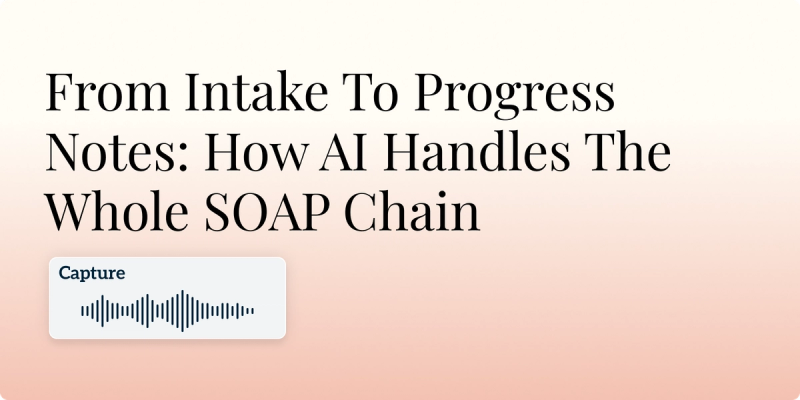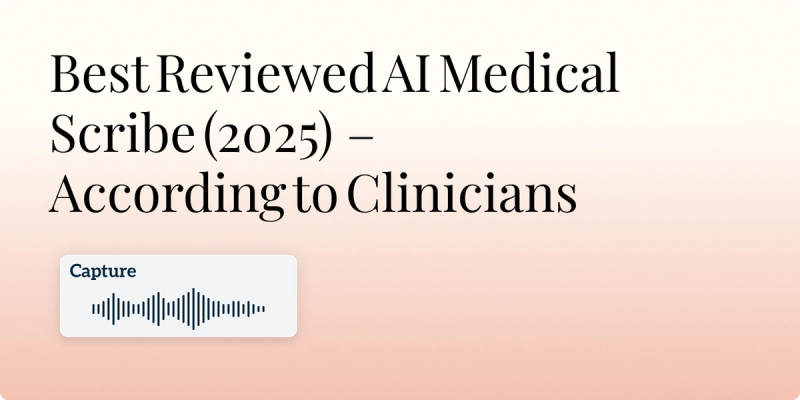
From Intake To Progress Notes: How AI Handles The Whole SOAP Chain

The clinical documentation lifecycle, from patient intake to ongoing progress notes, forms the narrative backbone of patient care. Yet, this chain is often fragmented. Data from intake forms are re‑typed into initial assessments, and critical context from early sessions can get lost in subsequent progress notes, creating a disjointed record that undermines continuity.
This fragmentation is precisely where AI SOAP notes deliver transformative value. By acting as a consistent, intelligent thread throughout the entire patient journey, AI seamlessly connects each stage of documentation. Explore how AI manages the complete clinical documentation workflow, from structuring initial intake data to generating context‑aware automated progress notes, ensuring a cohesive and accurate record from the very first encounter.
AI in the Patient Intake Process
The patient intake process establishes the foundational dataset for all subsequent care. AI SOAP notes transform this initial step from a passive data collection exercise into an active structuring of a patient's narrative.
- Concept: AI automates the collection, parsing, and organization of initial patient data directly into a clinical framework. It moves beyond simple digitization of forms to clinically intelligent data processing.
- Example: A patient completes a digital intake form, stating in an open text field:” I’ve had a persistent cough for three weeks, and I’m short of breath when I climb a flight of stairs.” A basic system would simply record this text. An AI scribe, however, parses this response using Natural Language Processing (NLP) to pre-populate the initial draft note with structured data:
- Subjective: ‘Chief Complaint: Cough and shortness of breath. Duration: 3 weeks. Aggravating Factors: Climbing one flight of stairs.”
- Past Medical History: The AI cross-references the patient's stated medication, “Lisinopril”, and can flag a potential side effect for the clinicians' review.
This process converts unstructured patient‑reported data into organized clinical notes, providing a strong foundation for the session. Learn more about our AI SOAP notes platform.
Crafting the Initial Assessment and Plan
Following intake, the clinician's initial assessment synthesizes the patient's history with observed findings and clinical reasoning. AI augments this critical phase by leveraging structured intake data and live clinical conversations to draft a comprehensive diagnostic formulation and treatment strategy.
- Concept: AI synthesizes structured intake data to generate a preliminary Assessment and Plan, which the clinician refines and finalizes.
- Example: Building on the intake data for a patient presenting with anxiety, the clinician conducts the diagnostic interview. The AI SOAP notes system listens and synthesizes both sources of information
- Intake Data: “Chief complaint: anxiety” “ reports difficulty sleeping” history of thyroid disorder”
- Clinical Dialogue: Patient states: “My mind races at night, and I've been avoiding social situations and gatherings.”
The AI drafts an initial assessment and plan for the clinicians' review:
- Assessment (Draft): “Generalized Anxiety Disorder with comorbid insomnia. Rule out contribution from thyroid dysfunction.”
- Plan (Draft): “1. Initiate Cognitive `Behavioral Therapy for Insomnia (CBT-I). 2. Schedule follow-up in 2 weeks. 3 Order TSH to assess thyroid function.”
The clinician then edits this draft to ensure it accurately reflects their clinical judgement, significantly accelerating the creation of a complex, personal treatment plan.
Automated Progress Notes for Ongoing Care
The true test of a documentation system is its ability to maintain a coherent narrative across multiple sessions. AI SOAP notes excel by using historical data to create automated progress notes that accurately reflect a patient's treatment trajectory.
In Practice:
AI leverages the entire patient history to generate context‑rich progress notes. It automatically references past assessments and treatment plans, highlighting changes in symptoms, mood, and functioning to support informed clinical decision‑making.
- Example: For a patient's fourth therapy session for social anxiety, the AI references the initial assessment and previous notes. It helps draft a note that contrasts the current functioning with the baseline:
- Subjective: “Reports applying relaxation techniques before a work meeting, stating ‘I felt less anxious this week than last month’. Contrasts with initial presentation of ‘avoiding all social gatherings’”.
- Objective: “Observed maintained eye contact for 85% of the session (increased from approximately 60% at intake ) and decreased self-soothing behaviors.”
- Assessment and Plan: The AI suggests continuing the current CBT protocol while noting the observed progress, allowing the clinician to quickly validate and sign off.
This automated comparison provides concrete evidence of progress or stagnation, making each note more clinically valuable than a standalone document.
How AI Maintains Consistency
Data Persistence and Context-Awareness
AI systems maintain a dynamic patient context model that references the entire treatment history. Using clinical language models, the system can identify unresolved problems from previous notes and ensure they're appropriately addressed in the current clinical documentation workflow. For example, if a patient's “fatigue” was noted as “pending labs” two visits ago, the AI will flag this unresolved issue for follow‑up in the current note.
Structured Data Adherence
Unlike free‑text documentation, AI systems enforce consistent SOAP formatting through predefined templates and data validation rules. This standardization ensures all necessary elements for billing and compliance are present while making notes instantly readable to any provider accessing the record. The system maintains HIPAA compliance throughout the entire documentation chain with enterprise‑grade security protocols.
Conclusion
By linking intake to progress notes, AI creates a seamless longitudinal record that tells the complete story of a patient's care journey. This connected approach transforms the clinical documentation workflow from a series of isolated tasks into a continuous clinical narrative powered by AI SOAP notes.
The outcome is a stronger foundation for treatment decisions and more personalized care plans, and significant time savings across the entire clinical workflow. This cohesive approach ensures that critical context is never lost between visits, and every automated progress note contributes to a comprehensive understanding of the patient's journey.
Frequently Asked Questions
ABOUT THE AUTHOR
Dr. Danni Steimberg
Licensed Medical Doctor
Reduce burnout,
improve patient care.
Join thousands of clinicians already using AI to become more efficient.

Best Reviewed AI Medical Scribe (2025) – According to Clinicians
See why clinicians rate these 7 AI scribes highest in 2025. Compare rankings, real‑world reviews, pricing and HIPAA safeguards to find the best AI scribe for you.

How to Write High Quality Clinic Notes: 5 Easy Steps
Learn how to write clear, comprehensive, and compliant clinic notes in five easy steps. Perfect for healthcare teams, medical practices, and mental health therapists.

What Is an AI Medical Scribe?
Discover how AI Medical Scribes automate clinical documentation, reduce physician burnout, and improve patient care.

